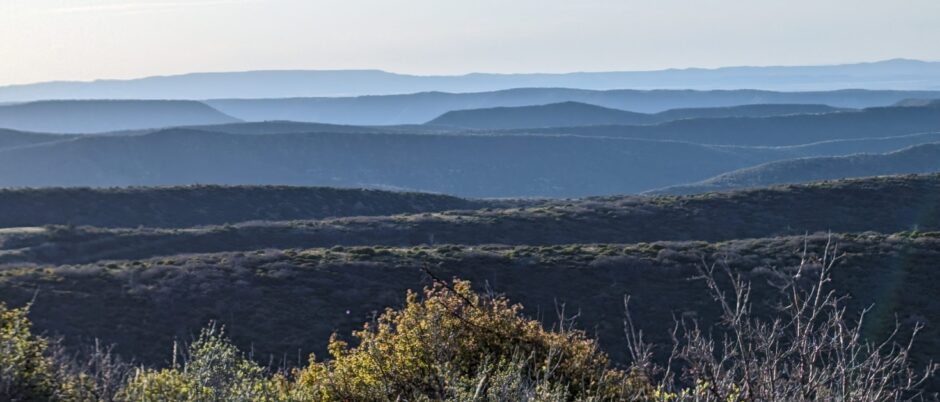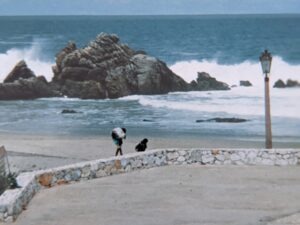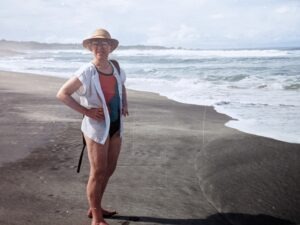In the works for fifteen years, the 104-kilometer Oaxaca to Puerto Escondido highway opens February 2024 and should reduce travel time to 2.5 hours. No one will now have my experience of that journey. On the other hand, the arrival of progress probably brings plumbing.
Travelog by Bus, 1993
In Oaxaca’s early morning, a father makes the sign of the cross over his grown daughter’s face before she hoists her bag to board the bus for Puerto Escondido. This is sometimes still a place where one doesn’t leave home without parental blessing. Cate and I are the only foreigners to board besides a few Australians coming for Escondido’s wicked surf.
A man fitting the short, dark Oaxacan type slides behind the wheel, his khaki uniform pants and white short-sleeved shirt immaculate, crisply pressed. He has a radio and tape player, but his altar décor is minimal—a saint’s face on the visor, tiny crucifix on the dash—no plastic flowers in a bolted vase, no icons or dangling rosaries.
Three rows behind him, I strain through diesel rumble to hear the talk show he’s listening to, one phrase making it past the racket: otro víctima de la policia. His mirrored lens sunglasses, lips in a deadpan line, reveal nothing in the rearview mirror. Once out of the city, political slogans painted on walls change to health advisories: La mejor solución para la diarrea es lavar las manos antes de comer. We pass through village after town, población después de población, pairs of Brahmas plowing fields, roadside shrines, thin dark people who pause hoeing to watch us pass on the narrow, empty road.
The Oaxaca station fades and the driver slides in a tape of popular ballads: No quiero olvidarte…I don’t want to forget you…We crawl through the last village, slowly topping tope after tope, speed bumps that mean business, begin a long, snaking climb out of the sprawling valley. The driver pops a chicklet into his mouth, jaw muscles working rhythmically as his arms, turning the horizontal wheel to its limit one way and then instantly the other as we rise out of palms into pines, the road tightening its coils. I watch the hairpins coming, grip my seat as the windshield edges over the abyss, falls back, edges out again.
The morning sun ascends the sky, pines grow taller, the mountains rockier and we could be in Colorado. I feel the easing of the engine which means we’ve reached the summit. Veinte minutos, the driver announces, crosses the road to a private entrance, a glimpse of steaming plate on the table before the door closes behind him. We step into moist, chilled air, chaffing gooseflesh from our summer-bare arms. Two wooden outhouses squat at the cliff’s edge, beside them a barrel of water, pails; within, white ceramic toilets. You pour the water into the toilet when you’re done, hear the trickle run downslope, slick, pungent and dotted with wads of soiled white.
Two stands across the road sell bags of cacahautes estilo japonés, tortas de jamón wrapped in cellophane. The air there is sweet as sherbet, the view layered range by range. No car passes while we walk, stretching our legs, no sign of habitation mars any slope. I feel far from civilization when a fellow traveler discovers our schoolhouse Spanish, asks what we think of Clinton, our new president. Cate says he’s así-así so far.
Twenty minutes exactly and our driver appears, so we scramble aboard, glad of some warmth. On the downslope, I munch my candied peanuts, watch the endless circling of the wheel, the slenderly muscled arms, the impassive face. Now I trust this man with my life, and sleep. When I wake pines are being replaced by thick leafy jungle, vines, flowers, flashes of color on the wing. A narrow creek tumbles over stones, half a dozen women on its bank, kneeling to wash clothes, their naked children splashing after a bright red ball. Like a museum diorama, they freeze as we cruise past.
Jungle yields to low hills of palm, cactus, and the curves become long and loose and straighten into a flat run through sand, pulsing ultramarine briefly visible to the west, where the sun now hovers. Stifling salted air wraps us as we crawl through seaside towns. At an intersection, the driver raises a greeting hand from the wheel. In the rearview mirror for the first time, a grin flickers. On the corner a woman smiles a welcome home smile, a woman who has been waiting for him to pass, the child asleep in her arms.



What a rich, lovely piece of writing, Pat! Among your very best….
Thanks, Joe! I keep writing because I believe I’m making progress.
How long did this journey take?
Jana, it was pretty much all day. Left Oaxaca around 8 a.m. and got to Puerto Escondido by mid or late afternoon, as I recall. The mountains were breathtaking, the two-lane road narrow and it was fascinating to see high altitude pine forest become almost tropical jungle on the way down. Also, no traffic. I’m sure with the new highway, it’s very different now.
Hard to imagine how they put a new highway where the “windshield edges over the abyss”
Jana, those big buses that do highway travel, the whole front is windshield? So when I’m looking at the driver from the 3rd seat, there’s nothing but glass between him and the road. In 1993, the road up that mountain was narrow, little between it and the cliff edge. It really looked like we were going over.I imagine the new highway involved a lot of cliff blasting, like we do here.
What a wonderful rhythm this piece has, matching the vacation vibe of the content. A dream, just like a walk on the beach. How masterful you have to be to let us have ease, free from any whiff of your industry! Thank you, Pat!
Thanks so much, Kitty! Many many revisions over much time.
Over the decades, I’ve been to Mexico maybe 25 times. I started at age 16, driving cars from my home in SoCal to Tijuana to get the upholstery done cheaply, efficiently and beautifully in a creative “tuck and roll” method popular at the time. Because I had such a dark tan from surfing and I combed my black hair in the local “Pachuco style” (short sides, a big front wave above my forehead) I was always stopped by immigration authorities on the American side of the border and harassed for several hours. Those men, fat and mean, thought I was a Mexican trying to sneak into the US.
When I was 19, a friend, who I got to know well at the New Mexico Institute of Mining and Technology in Socorro, NM, and I hitchhiked from Orange County, CA, to Mexico City. I was grateful that my 8th grade buddy, Charlie Martinez, had taught me how to look powerful with a knife in my hand, the few times I had to “act out.” I surfed the lovely waves at Mazatlan, which at the time, had two or three sleazy hotels.
We slept on the tops of tables at a taco joint so the ants wouldn’t bite us. Mexico City was huge, crowded, smoggy and fascinating. Years later, I was able to go to the spectacular Museum of Anthropology and feed my burgeoning interest in Meso-American archeology, after visiting the ruins at the Teotihucacan, Tulum, Chichen Itza, Uxmal and other places.
I’ve ridden 2nd class buses (chickens, but goats not allowed), trains, and mostly, driven a rental car everywhere. Recently, I looked at a map of the country and realized over the years I’ve been to almost every city large and small in the country. Except Oaxaca! I was saving that for last – it being the food capital of the country. But the narcos went wild there that year, so I never made the trip.
Generally, I prefer to visit the villages, towns and small cities, for the colorful architecture, good local food and shy, but friendly locals. And few, if any, tourists! El Mundo Maya, in the States of Yucatan, Quintana Roo and Campeche, is my favorite place to visit. The Maya people are extraordinarily polite and so very different than the Mexican people. Their history, under the rule of the Mexican government, is one of great tragedy and finally, worldwide redemption. But that’s a story for another time.
Quite a history of travel in Mexico, Michael! I love the story of you getting harrassed at the border because they thought you were Mexican.
Beautiful, Pat. Makes me want to walk on the beach. There’s nothing like it.
Yes, Pat! The American immigration officials were so suspicious that even with my CA driver’s license with my picture, my California “accent,” etc., they were hard to convince. Racism bites deep into the soul and psyche of all those who partake of it. “They harm others because there is nothing else they do well.” James Lee Burke.
Just beautiful. What an experience. Love how you frame it around the driver